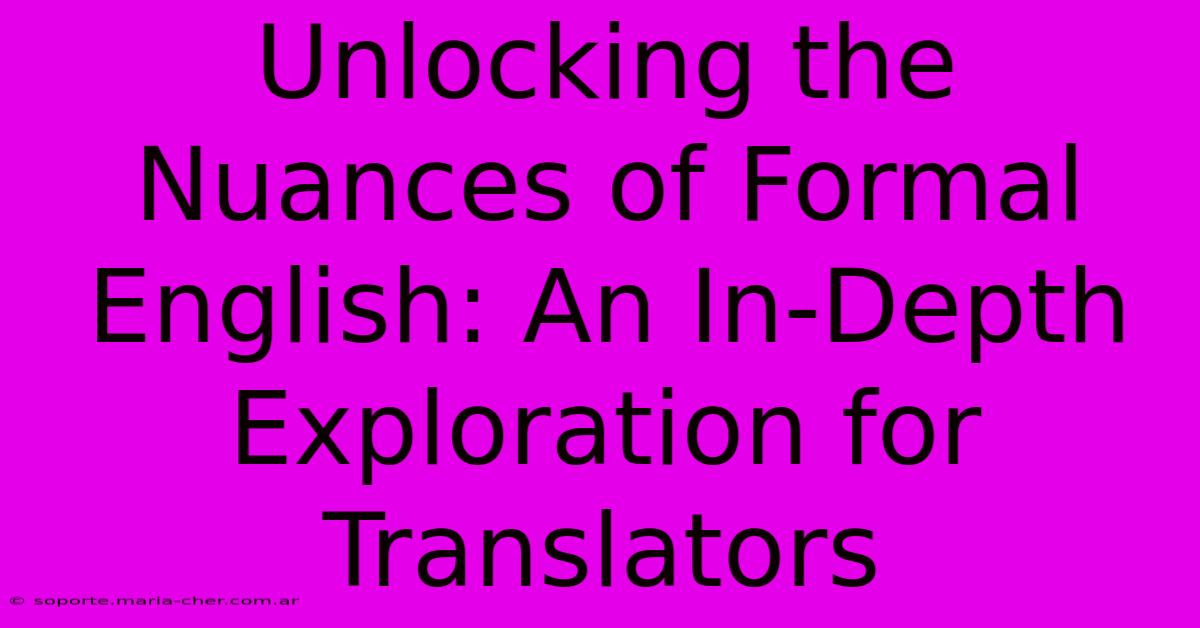Unlocking The Nuances Of Formal English: An In-Depth Exploration For Translators

Table of Contents
Unlocking the Nuances of Formal English: An In-Depth Exploration for Translators
Formal English presents unique challenges for translators, demanding a deep understanding beyond basic vocabulary and grammar. This article delves into the intricacies of formal English, providing insights and strategies crucial for accurate and effective translation. We'll explore key aspects, offering practical advice for translators navigating the complexities of this register.
Understanding the Characteristics of Formal English
Formal English isn't simply about avoiding contractions or slang. It encompasses a nuanced blend of linguistic choices that convey authority, professionalism, and respect. Key characteristics include:
1. Lexical Choices: Precision and Sophistication
Formal writing favors precise and sophisticated vocabulary. Avoid colloquialisms, idioms, and slang. Instead, opt for more formal synonyms. For example, instead of "get," consider using "obtain," "acquire," or "receive," depending on the context. This requires a robust vocabulary and a deep understanding of subtle semantic differences. A good dictionary and thesaurus are invaluable tools.
2. Grammatical Structures: Complexity and Clarity
Formal English often employs complex sentence structures, including subordinate clauses and participial phrases. However, complexity should not come at the cost of clarity. Maintain logical flow and ensure the message remains easily comprehensible. Overly long and convoluted sentences should be avoided. Prioritize clear and concise expression.
3. Tone and Style: Objectivity and Impersonality
Formal English generally adopts an objective and impersonal tone. Avoid subjective opinions, personal anecdotes, or informal expressions of emotion. Maintain a detached and professional stance, focusing on presenting information clearly and accurately. The use of the passive voice is more common in formal writing than in informal contexts.
4. Punctuation and Mechanics: Precision and Accuracy
Precise punctuation and adherence to grammatical rules are paramount in formal English. Pay close attention to comma usage, semicolon placement, and the proper use of apostrophes. Errors in punctuation and mechanics can undermine the credibility and professionalism of the text.
Challenges for Translators Working with Formal English
Translating formal English presents specific hurdles:
1. False Friends and Cultural Differences
Be mindful of "false friends" – words that look similar in different languages but have different meanings. Cultural differences in formality also play a significant role. What is considered formal in one culture might be informal in another. Thorough research and cultural sensitivity are essential.
2. Maintaining Register Consistency
Consistency in register is vital. Switching between formal and informal styles within a single text can disrupt the flow and undermine the overall effect. Maintain a consistent level of formality throughout the translation.
3. Handling Technical Terminology
Formal texts, especially in specialized fields, often contain technical terminology. Accuracy in translating technical terms is crucial. Consult specialized dictionaries and glossaries to ensure precision and avoid misinterpretations.
Strategies for Successful Translation of Formal English
1. Deep Understanding of Source Text
Before beginning the translation, thoroughly analyze the source text. Identify the intended audience, purpose, and overall tone. This understanding will guide your choices in the target language.
2. Comprehensive Research
Consult reliable dictionaries, thesauruses, and specialized glossaries to find the most appropriate equivalents for specific words and phrases.
3. Style Guide Adherence
If a style guide is provided, adhere to its specifications diligently. Style guides often provide specific guidelines for punctuation, formatting, and terminology.
4. Peer Review and Editing
Have a colleague or editor review your translation to identify any inconsistencies or errors in formality. A fresh pair of eyes can catch mistakes that you might have missed.
5. Continuous Learning
Formal English is a constantly evolving field. Stay updated on linguistic changes and best practices by regularly reading professional publications and participating in relevant professional development activities.
Conclusion
Translating formal English requires meticulous attention to detail, a strong command of both the source and target languages, and a deep understanding of cultural nuances. By mastering the techniques and strategies outlined above, translators can confidently navigate the complexities of formal English and produce accurate, professional, and impactful translations. Continuous learning and a commitment to precision are key to success in this challenging but rewarding field.

Thank you for visiting our website wich cover about Unlocking The Nuances Of Formal English: An In-Depth Exploration For Translators. We hope the information provided has been useful to you. Feel free to contact us if you have any questions or need further assistance. See you next time and dont miss to bookmark.
Featured Posts
-
Omelette Vs Omelet The Ultimate Guide To Eggcellent Cuisine
Feb 09, 2025
-
Beat The Bank How To Secure The Best Deal On Carpal Tunnel Surgery
Feb 09, 2025
-
The Speed Limit Exploring The Boundaries Of Human Agility In Baseball
Feb 09, 2025
-
Beat The Pain 5 Hacks For Faster Toe Amputation Healing
Feb 09, 2025
-
2
Feb 09, 2025
